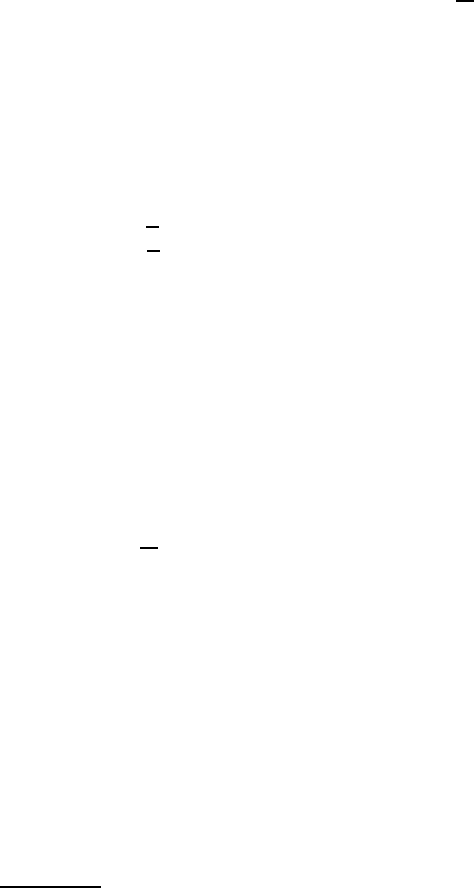Galdi G.P. An Introduction to the Mathematical Theory of the Navier-Stokes Equations: Steady-State Problems
Подождите немного. Документ загружается.


846 XII Two-Dimensional Flow in Exterior Domains
such that
w ∈ C
q
, τ ∈ D
1,q
(Ω).
This solution satisfies the estimate
hwi
λ,q
≤ ckfk
q
(XII.5.3 9)
for all λ ∈ (0, λ
0
] (λ
0
given in Lemma XII.5.1) and with c = c(Ω, q, λ
0
).
Moreover, if w
1
, τ
1
is another solution to (XII.5.38) corresponding to the
same data and with hw
1
i
λ,q
finite,
4
then w = w
1
.
Proof. Extend f to zero outside Ω and continue to denote by f this extension.
We look for a solution w, τ of the form
w = v + u, τ = p + π (XII.5 .40)
where
∆v + λ
∂v
∂x
1
= ∇p + f
∇ · v = 0
in R
2
while u, π solve problem (XII.5.6) with u
∗
= −v at ∂Ω. From Theorem
VII.4.1 we know that there is a unique solution v, p satisfying the estimate
hvi
λ,q
+ |v|
2,q
+ |p|
1,q
≤ c
1
kf k
q
(XII.5.4 1)
with c
1
independent of λ ∈ (0, 1]. We need another estimate for a suitable
norm of v on the unit ball B centered at the origin. To this end, we write v
as the Oseen volume potential (VII.3 .50)
1
5
v(x) =
Z
R
2
E(x − y; λ) · f(y)dy =
Z
R
2
E(λ(x − y); 1) · f (y)dy
where the homogeneity property (XII.5.15) has been employed. By the H¨older
inequality we have (with q
0
= q/(q −1))
|v(x)|
q
0
≤
Z
R
2
|E(λ(x − y); 1)|
q
0
dy
kf k
q
0
q
.
Since
Z
R
2
|E(λ(x − y); 1)|
q
0
dy ≤ λ
−2
Z
R
2
|E(z; 1)|
q
0
dz = cλ
−2
,
it follows that
kvk
q
0
,B
≤ 2πcλ
−2(1−1/q)
kfk
q
, (XII.5. 42)
4
Of course, w
1
and τ
1
satisfy (XII.5.38) in the sense of Definition VII.1.1(v).
5
This is easily shown by a standard approximating procedure that starts with
f ∈ C
∞
0
(Ω) and uses (XII.5.41).

XII.5 Existence and Uniqueness of Solutions for Small Data and v
∞
6= 0 847
which is the inequal ity we wanted to show. We now pass to the solution u, π.
From Lemma XII.5.1 we know that
u ∈ C
q
, π ∈ D
1,q
(Ω)
and that for all λ ∈ (0 , λ
0
]
hui
λ,q
≤ c
2
λ
2(1 −1/q )
kvk
2−1/q,q(∂Ω)
. (XII.5.43)
Our task is to increase the right-hand side of (XII.5.4 3) in terms of f . To
this end, we observe that by the trace Theorem II.4.4, the Ehrling inequality
(II.5.20), and the H¨older inequality,
6
kvk
2−1/q,q(∂Ω)
≤ c
3
kvk
2,q ,Ω
1
≤ c
4
(kvk
q,Ω
1
+ |v|
2,q,Ω
1
)
with c
5
depending o nly on Ω. Since q
0
> q, from this latter inequality and
(XII.5.4 1)–(XII.5.43) we conclude, for all λ ∈ (0, λ
0
], that
hui
λ,q
≤ c
5
kf k
q
(XII.5.4 4)
with c
6
= c
6
(Ω, q, λ
0
). Estimate (XII.5.39) then becomes a consequence of
(XII.5.4 0), (XII.5.41), and (XII.5.44). To show the result completely we have
to prove the uniqueness part. However, this follows from Exercise VII.6.2 once
we notice that w and w
1
are 3q/(3 − q)-generalized solutions to the Oseen
problem corresponding to the same data (cf. Remark XII.5.1). ut
Remark XI I.5.3 Lemm a XII.5.2 can be extended to the case q = 6/5. In
such a situation we may take λ
0
= 1.
Combining Lemma XII.5.1 and Lemma XII.5.2, we immediately obtain
the following result.
Lemma XII.5.3 Let Ω be as in Lemma XI I.5.1. Then, given
f ∈ L
q
(Ω), u
∗
∈ W
2−1/q,q
(∂Ω), 1 < q < 6/5,
there is a unique solution to the Oseen problem
∆u + λ
∂u
∂x
1
= ∇π + f
∇ · u = 0
in Ω
u = u
∗
at ∂Ω
lim
|x|→∞
u(x) = 0
such that u ∈ C
q
, π ∈ D
1,q
. Moreover, there is a λ
0
> 0 such that for all
λ ∈ (0, λ
0
], this solution sati sfies
6
We may assume, without loss, that Ω
c
is contained in B
1/2
.

848 XII Two-Dimensional Flow in Exterior Domains
hui
λ,q
≤ c
h
λ
2(1 −1/q )
|log λ|
−1
ku
∗
k
2−1/q,q(∂Ω)
+ kfk
q
i
,
with c = c(Ω, q, λ
0
).
Finally, we need the following result concerning functions having a finite
h·i
λ,q
-norm.
Lemma XII.5.4 Let Ω be an arbitrary domain in R
2
and let v, w be two
solenoidal vector functions in Ω for which the norm (XII.5.4), with 1 < q ≤
6/5, is finite. Then the following inequality holds for all λ > 0
kv · ∇wk
q
≤ 4λ
−1−2(1−1/q)
hvi
λ,q
hwi
λ,q
.
Proof. Taking into account that v and w are divergence-free, we obtain
v · ∇w =
−v
1
∂w
2
∂x
2
+ v
2
∂w
1
∂x
2
e
1
+
−v
1
∂w
2
∂x
1
+ v
2
∂w
2
∂x
2
e
2
and so, by the H¨older inequality and (XII.5.4),
kv · ∇wk
q
≤
kv
1
k
3q/(3−2q)
|w
2
|
1,3/2
+ kv
2
k
3
|w|
1,3q/(3−q)
≤
λ
−2/3
|w
2
|
1,3/2
hvi
λ,q
+ λ
−1/3
kv
2
k
3
hwi
λ,q
.
(XII.5.4 5)
From the interpolation inequality (II.2.10) we find (with q
0
= q/(q − 1)) that
|w
2
|
1,3/2
≤ |w
2
|
3/q
0
1,q
|w
2
|
1−3/q
0
1,3q/(3−q)
≤ λ
−2/q
0
−1/3
hwi
λ,q
kv
2
k
3
≤ kv
2
k
6/q
0
2q/(2−q)
kvk
1−6/q
0
3q/(3−2q)
≤ λ
−2/q
0
−2/3
hvi
λ,q
and the lemma becomes a consequence of this relation and (XII.5. 45). ut
We are now in a position to prove an existence and uniqueness result for
the nonlinear problem. We shall prove it when Ω is an exterior doma in, leaving
to the reader the (much si mpler) case where Ω = R
2
in Exercise XII.5.1.
Theorem XII.5.1 Let Ω ⊂ R
2
be an exterior domain of class C
2
and let
f ∈ L
q
(Ω), v
∗
∈ W
2−1/q,q
(∂Ω), v
∞
= e
1
with q ∈ (1, 6/5). There exists a positive constant λ
0
> 0 such that if for some
λ ∈ (0, λ
0
],
|log λ|
−1
kv
∗
+ e
1
k
2−1/q,q(∂Ω)
+ λ
2/q−1
kf k
q
< 1/32c
2
, (XII.5.46 )
with c given in L emma XII.5.3, then problem (XII.0.1), (XII.0.2) (with R ≡ λ)
has at least one solution v, p such that

XII.5 Existence and Uniqueness of Solutions for Small Data and v
∞
6= 0 849
v
2
∈ L
2q/(2−q)
(Ω) ∩ D
1,q
(Ω)
v + e
1
∈ L
3q/(3−2q)
(Ω) ∩ D
1,3q/(3−q)
(Ω) ∩ D
2,q
(Ω)
p ∈ D
1,q
(Ω).
Furthermore, this solution satisfies the estimate
hv + e
1
i
λ,q
≤ c
2
λ
2(1−1/q)
|log λ|
−1
kv
∗
− e
1
k
2−1/q,q(∂Ω)
+ λkfk
q
(XII.5.4 7)
where h·i
λ,q
is defined in (XII.5.4). Finally, if v
1
, p
1
is another solution to
problem (XII.0.1), (XII.0.2) corresponding to the same data such that
cλ
−2(1−1/q)
hv
1
+ e
1
i
λ,q
< 13/64, (XII.5.48)
then v ≡ v
1
and p ≡ p
1
+ const.
Proof. We look for a solution v to (XII.0.1), (XII.0.2) o f the form
v = u
0
+ λ
2(1 −1/q )
u + e
1
, p = p
0
+ λ
2(1 −1/q )
π, (XII.5.49)
where
∆u
0
+ λ
∂u
0
∂x
1
= ∇p
0
+ λf
∇ · u
0
= 0
in Ω
u
0
= v
∗
+ e
1
at ∂Ω
lim
|x|→∞
u(x) = 0
(XII.5.5 0)
and
∆u + λ
∂u
∂x
1
= λ[λ
2(1 −1/q )
u · ∇u +λ
2(1 −1/q )
u
0
·∇u
0
+u
0
·∇u + u · ∇u
0
] + ∇π
∇ · u = 0
in Ω
u = 0 at ∂Ω
lim
|x|→∞
u(x) = 0.
(XII.5.5 1)
A solution to (XII.5.50) is determined by Lemma XII.5.3. For all λ ∈ (0, λ
0
]
such a solution obeys the estima te
hu
0
i
λ,q
≤ c
λ
2(1 −1/q )
|log λ|
−1
ku
∗
k
2−1/q,q(∂Ω)
+ λkfk
q
≡ D. (XII.5.52)
A solution to (XII.5.51) is likewise obtained from Lemma XII.5.1 with the
help of the contraction-mapping theorem. To this end, for λ ∈ (0, λ
0
], set

850 XII Two-Dimensional Flow in Exterior Domains
B
λ,q
=
w : Ω → R
2
: hwi
λ,q
< ∞; ∇·w = 0 in Ω; w = 0 at ∂Ω
.
Clearly, B
λ,q
is a Banach space endowed with the norm h·i
λ,q
. For δ > 0, let
X
λ,q,δ
= {w ∈ B
λ,q
: hwi
λ,q
≤ δ}.
Consider the mapping
L : w ∈ X
λ,q,δ
→ L(w) = u ∈ B
λ,q
, (XII.5.53)
where u solves
(∇u, ∇ϕ) = −λ(
∂u
∂x
1
, ∇ϕ) − (F(w), ϕ) (XII.5.54)
for a ll ϕ ∈ D(Ω), with
F(w) = λ
λ
2(1 −1/q )
w · ∇w + λ
−2(1−1/q)
u
0
· ∇u
0
+ u
0
· ∇w + w · ∇u
0
.
(XII.5.5 5)
By Lemma XII.5.4 it follows that
kF(w)k
q
< ∞,
and so, by Lemma XII.5.2, we derive that the mapping (XII.5.53) is well
defined and that the solution u verifies
u ∈ D
2,q
(Ω), π ∈ D
1,q
(Ω) (XII.5.56)
where π is the pressure field associated to u by Lemma VII.1.1. Thus, in
particular, u(x) tends to zero uniforml y as |x| → ∞; cf. Remark XII.5.1. We
next show that, given λ ∈ (0, λ
0
] there is a δ = δ(λ) > 0 such that L is
a contraction in X
λ,q,δ
, provided the data obey condition (XII.5.46). From
Lemma XII.5.4, (XII.5.52), and (XII.5.55) we find
kF(w)k
q
≤ 4
hwi
2
λ,q
+ λ
−4(1−1/q)
D
2
+ 2λ
−2(1−1/q)
Dhwi
λ,q
and therefore, in view of Lemm a XII.5.3, we obtain that for any w ∈ X
λ,q,δ
there is a unique solution u to (XII.5.54)–(XII.5.55) satisfying (XII.5.56) such
that
hui
λ,q
= hL(w)i
λ,q
≤ 4c
hwi
2
λ,q
+ λ
−4(1−1/q)
D
2
+ 2λ
−2(1−1/q)
Dhwi
λ,q
.
(XII.5.5 7)
Since hwi
λ,q
≤ δ, the preceding inequality yields
hL(w)i
λ,q
≤ 4c
δ
2
+ λ
−4(1−1/q)
D
2
+ 2λ
−2(1−1/q)
Dδ
. (XII.5.58)
Thus, taking (for instance)

XII.5 Existence and Uniqueness of Solutions for Small Data and v
∞
6= 0 851
δ ≡ λ
−2(1−1/q)
D < (32c)
−1
, (XII.5.5 9)
from (XII.5.57) it follows for all λ ∈ (0, λ
0
] that
hL(w)i
λ,q
≤ 4c ·
δ
8c
=
δ
2
, (XII.5.60)
which furnishes that the mapping (XII. 5.53) transforms X
λ,q,δ
into i tself, with
δ given in (XII.5.59). It is now simple to show that, in fact, L is a contraction in
X
λ,q,δ
. Actually, performing the same kind of reasoning leading to (XII.5.57 ),
for a ny w
1
, w
2
∈ X
λ,q,δ
we show
hL(w
1
) −L(w
2
)i
λ,q
≤ 4c[2λ
−2(1−1/q)
hu
0
i
λ,q
hw
1
− w
2
i
λ,q
+ (hw
1
i
λ,q
+ hw
2
i
λ,q
) hw
1
−w
2
i
λ,q
]
and so, by (XII.5.52) and (XI I.5.59) we deduce that
hL(w
1
− L(w
2
)i
λ,q
≤ 8c
λ
−2(1−1/q)
D + δ
hw
1
−w
2
i
λ,q
≤
1
2
hw
1
− w
2
i
λ,q
,
which proves that L is a contraction in X
λ,q,δ
. We may thus conclude that,
under the assumption (XII.5.59) (that is, (XII.5.46)) on v
∗
, f , and λ, problem
(XII.5.5 1) admits at least one solution u with hui
λ,q
finite. In fact, in view of
Lemma XII.5.2, it follows that u, π also sati sfy condition (XII.5.56) with π
pressure field associated to u. As a consequence, the fields (XII.5.49 ) consti-
tute a solution to (XII.0.1), (XII.0.2). Furthermore, by (XII.5.52), (XII.5.59),
and (XII.5.60) we find that v also satisfies estimate (XII.5.47). It remains to
show uniqueness. Setting
w = v − v
1
, π = p − p
1
,
we have
∆w + λ
∂w
∂x
1
= ∇π + g
∇ · w = 0
in Ω
w = 0 at ∂Ω
lim
|x|→∞
w(x) = 0.
where
g := λ (w · ∇u
1
+ u · ∇w) .
From Lemma XII.5.3 and Lemma XII.5.4 it follows that
hwi
λ,q
≤ 4cλ
−2(1−1/q)
hwi
λ,q
(hu
1
i
λ,q
+ hui
λ,q
) . (XI I.5.61)
By a direct computation that makes use of (XII.5.57)–(XII.5.59) we find
852 XII Two-Dimensional Flow in Exterior Domains
4cλ
−2(1−1/q)
(hu
1
i
λ,q
+ hui
λ,q
) < 1
so that (XII.5.61) implies w ≡ 0, thus completing the proof of the theorem.
ut
Remark XI I.5.4 It is worth observing that Theorem XII.5.1 does no t re-
quire that the datum v
∗
satisfies the zero-outflux condition:
Z
∂Ω
v
∗
· n = 0.
Remark XI I.5.5 We wish to emphasize that Theorem XII.5.1 furnishes ex-
istence (and uniqueness) for the physically significant problem obtained by
setting v
∗
≡ f ≡ 0, and describing the (plane) steady flow of a viscous liq-
uid around a cylinder translating with constant speed. Let us denote by P
this problem. For problem P, the assumption (XII.5.46) reduces, in fact, to
|log λ| > c, for some c = c(Ω) > 0, which i s certainly satisfied by taki ng λ
sufficiently small, which means, small translating speed. It is also interesting
to observe that the logarithmic factor, that i s crucial to prove such a result,
comes from the estimate of the total force, T = T (λ), exerted by the liquid o n
the cylinder in the Oseen approximation, and provided in Theorem VII.8.1.
As we know, in the class of generalized solutions to the Oseen approximation
T (λ) is not zero for all λ > 0, while it becomes zero in the Stokes approxi-
mation, that corresponds to λ = 0 (Stokes paradox, see Remark V.3.5). So,
we are expecting T (λ) → 0 as λ → 0, and Theorem VII.8.1 gives us an esti-
mate of the rate at which this happens. Consequently, if there were no Stokes
paradox, we would have not been able to prove existence for problem P!
Remark XI I.5.6 Solutions determined in Theorem XII.5.1 are unique in
the class of those sol utions verifying (XII.5.48). This result is much weaker
than the analogous one proved for the three-dimensional case. In fact, for the
situation at hand, we must require that both v a nd v
1
are smal l in sui table
norms, and it is not known if a solution v obeying (XII.5.4 6) is unique in
the class of those solutions v
1
that merely satisfy the condition hv
1
i
λ,q
< ∞;
cf. a lso Section XII.2.
Remark XI I.5.7 Si nce q < 6/5, solutions determined in Theorem XII.5.1
belong to D
1,s
(Ω), for some s < 2. Moreover, they are generalized solutions
in the sense o f Definiti on IX.1.1. In fa ct, they obviously satisfy conditio ns
(ii)-(v). Furthermore, since v ∈ D
2,q
(Ω) ∩ D
1,3q/(3−q)
(Ω), 1 < q < 6/5, by
Theorem II.6.1, it follows that v ∈ D
1,2q/(2−q)
(Ω) and so, noticing that
3q/(3 −q) < 2 < 2q/(2 − q)
we conclude, by interpolation, that v ∈ D
1,2
(Ω) and so also issue (i) of Defi-
nition X.1.1 is verified.

XII.6 A Necessary Condition for Non-Existence with Arbitrary Large Data 853
Remark XI I.5.8 Solutions determined in Theorem XII.5.1 satisfy the en-
ergy equality; cf. Corollary XII.7.1.
Exercise XII.5.1 Let f ∈ L
q
(R
2
), 1 < q ≤ 6/5. Show that there is an M > 0 such
that if
λ
2/q−1
kf k
q
< M,
problem (XII.0.1), (XII.0.2) in Ω = R
2
with v
∞
= e
1
admits at least one solution
v, p satisfying the following properties:
hvi
λ,q,R
2 < ∞, v ∈ D
2,q
(R
2
), p ∈ D
1,q
(R
2
).
Discuss also the uniqueness of these solutions.
XII.6 A Necessary Conditi on for Non-Existence with
Arbitrary Large Data
In the previous section we have shown existence of solutions correspo nding
to v
∞
6= 0, provided the size of the data is suitably restricted (depending
on the Reynolds number). On the other side, we know from Section XII.2
and Section XII.3 that, for data of arbi trary size (and sufficiently smooth),
1
we can construct a correspo nding pair (v, p) satisfying (XII.0. 1). As far as
the behavior at infinity is concerned, namely, (XII.0.2), at least in the very
significant physical case v
∗
≡ f ≡ 0, we know that such a v tends, as |x| → ∞,
to a vector v
0
, in a suitable sense, and, in the case of symmetric flow, even
uniform ly po intwise; see Theorem XII.3.4 and Remark XII.3 .2. However, we
do not know if v
0
= v
∞
.
At this point, it appears natural to investigate whether solutions corre-
sponding to large data do exist. This question ha s been taken up by Galdi
(1999b) in the case when v
∗
≡ f ≡ 0 and Ω p ossesses an axis of symmetry,
that we may take coincident with the x
1
-axis (say). Under such assumption
on the data and after suitable scaling, we may rewrite the original problem
(XII.0.1 )–(XII.0.2) as follows
∆v = v ·∇v + ∇p
∇ · v = 0
)
in Ω
v|
∂Ω
= 0
lim
|x|→∞
(v(x) + λe
1
) = 0 ,
(XII.6.1 )
where, as in the previous section, we have denoted by λ the Reynolds number.
As we mentioned in the Introduction, (XII.6.1) describes one of the most
studied problems in fluid dy namics, namely, the plane, steady-state motion of
1
We are thinking of boundary data with zero or even “small” flux, in the sense
specified in (X.4.47).

854 XII Two-Dimensional Flow in Exterior Domains
a viscous liquid around a cylinder of symm etric cross-section (e.g., a circle),
that translates with constant speed λ in the positive e
1
-direction orthogonal
to its axis. The existence problem for arbitrary data is then equivalent, in
this situation, to findi ng solutions to (XII.6.1) for any prescribed value of
λ > 0.
2
Since the smoothness of Ω is i rrelevant, we may assume Ω of class
C
∞
(e.g., the exterior of a circle), so that any solution (v, p) to (XII.6.1)
with v ∈ W
1,2
(Ω
R
), for all large R > 0, is C
∞
(Ω); see Theorem X.1.1.
Thus, given λ > 0, we denote by C (λ) the class of solutions to (XII.6.1) with
v ∈ W
1,2
(Ω
R
), a ll R > δ(Ω
c
), and such that
lim
r→∞
Z
2π
0
|v(r, θ) −λe
1
|dθ = 0 .
The following result holds (Galdi 1999 b, Theorem 4.1; Galdi 2004, §4.3).
Theorem XII.6.1 Let Ω be smooth and symmetric around the x
1
-axis. Sup-
pose there exists λ > 0 such that problem (XII.6.1) has no solution in the class
C (λ) for all λ ≥ λ. Then, the f ollowing homogeneous problem
∆u = u · ∇u + ∇τ
∇· u = 0
)
in Ω
u|
∂Ω
= 0
lim
|x|→∞
u(x) = 0 uniformly pointwise ,
(XII.6.2 )
must have a non-zero solution (u, τ ) such that:
(i) (u, τ) is symmetric around the x
1
-axis, in the sense specified in Remark
XII.3.2;
(ii) u, τ ∈ C
∞
(Ω);
(iii) ∇u, ∇τ ∈ W
m,q
(Ω), for all m ≥ 0 and q ≥ 2;
(iv) For all | α| ≥ 0, lim
|x|→∞
D
α
u(x) = 0, lim
|x|→∞
D
α
τ (x) = 0, unif ormly point-
wise.
We shall no t prove this result here and refer the interested reader to Galdi,
loc. cit.. Instead, we limit ourselves to observe that the proof is given by
contradiction, namely, if (XII.6.2 ) has only the zero solution, u ≡ ∇τ ≡ 0, in
the class (i)–(iv), then problem (XI I.6.1) has at least a solution in the class
C (λ) for all λ belonging to a suitable unbounded set.
We would like to make some comments about the above result. A sufficient
condition to show that (XII.6.2) has only the zero solution is the existence of
an unbounded sequence of numbers {R
m
}
m∈N
, such that
2
From Theorem XII.7.2, we know that existence holds for all λ ∈ (0, λ
0
], for some
λ
0
> 0.

XII.7 Global Summability of Generalized Solutions when v
∞
6= 0 855
lim
R
m
→∞
Z
2π
0
1
2
u
2
(R
m
, θ) + τ(R
m
, θ)
u(R
m
, θ) · x
m
= 0, (XII.6.3)
where x
m
= (R
m
, θ). Actually, multiplying both sides of (XII.6.2)
1
by u and
integrating by parts over Ω
R
, we find
Z
Ω
R
|∇u|
2
=
Z
|x|=R
u ·
∂u
∂n
−(
1
2
u
2
+ φ)u · n
. (XII.6.4)
Since ∇u ∈ W
1,2
(Ω), we deduce
lim
R→∞
Z
|x|=R
∂u
∂n
= 0.
Therefore, from (XII.6 .4) and the fact that u is bounded, we obtai n
Z
Ω
R
|∇u|
2
= − lim
R→∞
Z
|x|=R
1
2
u
2
+ φ
u · n,
and so, if (XII.6.3) is satisfied, we conclude u ≡ 0, by “classical” uniqueness
method.
We also notice that in the case when Ω = R
2
(an unrealistic assumption
in our present situation) the uniqueness of the zero solution to (XII.6.2) fol-
lows from Theorem XII.3.1, and it appears very intriguing the idea that the
introduction of a compact bounda ry may derail thi s property.
Finally, the possibility that (XII.6.2 ) may admit a non-zero smooth solu-
tion is very questionable on physical grounds, and the occurrence of such a
situation would give less credibility to the Navier–Stokes model, or, at the
very least, would cast serious doubts on the meaning of the two-dimensional
assumption.
XII.7 Global Summability of Generalized Solutions
when v
∞
6= 0
In this and the next section we shall analy ze the asymptotic properties of
generalized solutions correspo nding to v
∞
6= 0. Specifically, we shall prove a
result analogous to that obtained in Section X.5 for three-dimensional mo-
tions, namely, that every generalized solution tending at infinity to a nonzero
velocity field v
∞
shows asymptoti cally the same behavior as the Oseen fun-
damental solution.
On the other hand, if v
∞
= 0, the structure of a generalized sol ution at
large distances is a completely open question. In this regard, it should be
emphasized that, when v
∞
= 0, generalized solutions that are regular in a
neighborhood of infinity need not be represented there by an expansion in
“reasonable” functions of r ≡ |x| with coefficients independent of r. Actually,
